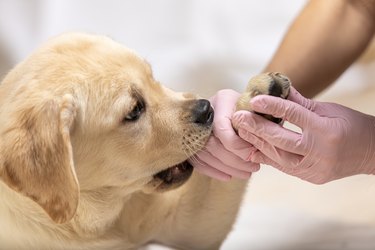Canine bandages are an important tool to protect a dog's back leg after surgery or following an injury. They work to prevent dirt or debris from entering the injured area and causing an infection. You can also bandage a dog's leg to prevent them from licking the area and irritating the wound.
We spoke with Dr. Ingrid Taylor, a veterinarian with 16 years of experience in general clinical and emergency practice and public health, to get basic instructions on how to bandage a dog's back legs. But, she notes, each wound situation is different, so bandages should be applied according to your veterinarian's instructions. "Be sure to also follow all directions for bandage care and follow up appointments," says Dr. Taylor.
Video of the Day
Video of the Day

How to bandage a dog’s back leg
Carefully place a nonstick gauze pad on your dog's wound. This first layer is designed to protect the leg wound or surgical site. If your veterinarian provided you with an antibiotic cream, squeeze the tube to place a ribbon of the cream on the wound and place the nonstick gauze pad on top.
Next, you will add a layer of rolled gauze bandage to hold the previous layer in place. Place the loose end of a roll of gauze about 1 inch below the bottom of the nonstick pad and hold it in place with one hand. Using the other hand, wrap the gauze bandage in a spiral motion around your dog's leg going upward. Overlap each layer into the center of the previous layer until you reach approximately 1 inch above the nonstick pad. When rolling the gauze bandage around your dog's leg, you want it to be tight enough to hold the gauze pad in place but not too tight.
The final layer of your dog's bandage is a self-adhesive material called veterinarian wrap. Roll this adhesive bandage on top of the rolled gauze layer in the same manner as it was applied. Make sure that it fully covers the gauze layer.
Veterinarian wrap is highly elastic and will self-tighten and cinch down after it has been applied, holding everything in place. "To keep it from cutting off circulation to your dog's paw, make sure to wind it around the leg firmly enough to keep it in place but don't pull and stretch it too tightly," Dr. Taylor says. "If the bandage is around a splint or if your dog has suffered a sprain or fracture, call your veterinarian for instructions on how to apply the bandage properly. You should also get advice for bandages that are too loose or slipping down."
To prevent the bandages from getting wet, tape a plastic shopping bag over the bandaged leg when your dog goes outside. Remove the plastic bag as soon as they return inside to prevent your dog from chewing at it and swallowing or suffocating from the bag. Another option would be to use a dog bootie to protect the bandage.

Only use bandages designed for dogs
"Only use bandages that are designed for dogs," says Dr. Taylor. "Traditional human bandages or medical adhesive tape may appear to be a good substitute, but these bandages will stick to the hair on your dog's leg. This will cause pain and discomfort for your dog when it comes time to change the bandage."
If you check your pet first-aid kit and find that there are no gauze bandages or veterinarian wrap, don't substitute it with a human bandage. The bandage material used in human bandages may also be easier for your dog to remove. Chewing the bandage can lead to your dog ingesting pieces of the bandage, putting them at risk of a blockage.

Regular wound care will prevent infections
Proper wound care of your dog's injury or surgical site will require more than just applying the bandage. Check your dog's bandage twice daily to make sure that they don't smell. "At this time, it is important to also check their toes to make sure that they are not swollen, hot, or cold," says Dr. Taylor. "If you notice any of these signs, then the bandage is too tight and should be immediately loosened."
Look over the bandage carefully to make sure that it isn't too loose and slipping down at all. You also want to check for signs that your dog may be chewing at the bandage. If you suspect that your dog has been trying to remove the bandage, they may benefit from wearing an Elizabethan collar. It will restrict your dog from being able to reach their rear leg and the bandage that protects it.
Contact your veterinarian if you notice any problems
While checking the state of your dog's bandage each day, you should also check for any signs that the area may not be healing properly. If the bandage is wet or soiled with feces or dirt, it will need to be changed to prevent an infection from forming. Any sign of blood, swelling above or below the bandage, discharge, or unpleasant smells could signal that an infection has already formed.
"If you identify any reasons to be concerned, contact your veterinarian," warns Dr. Taylor. "Even a minor infection can progress and put your pet's health at risk."
The bottom line
Whether your dog has recently had surgery or suffered an injury, caring for and changing their bandage as recommended by your veterinarian is necessary for proper healing. A properly applied bandage will include a nonstick gauze pad to protect the wound area, a roll of gauze to hold that pad in place, and a final layer of veterinarian wrap to keep everything protected. Make sure not to wrap your dog's bandage too tightly and watch for any signs of infection. Contact your veterinarian if you notice any cause for concern.